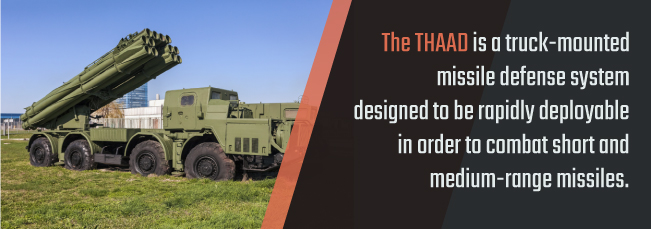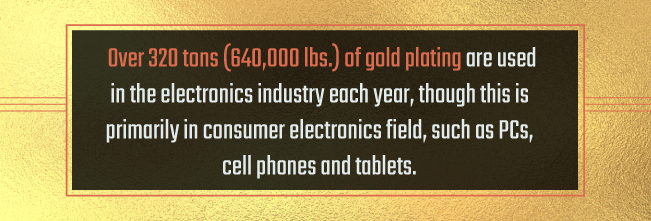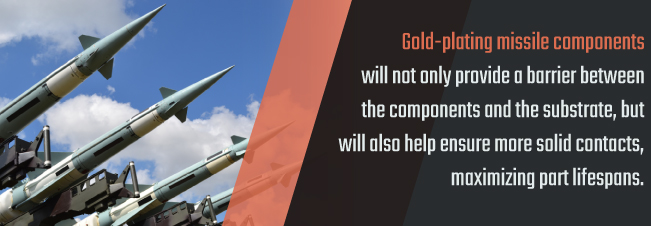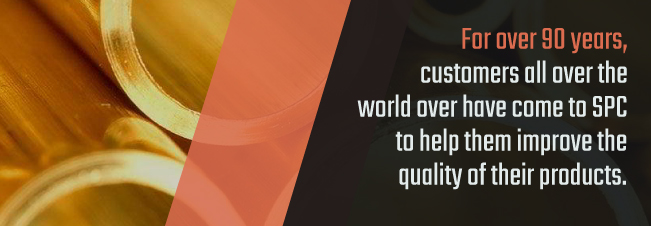Since the introduction of ground defense systems in the 1950s and 1960s, companies such as Raytheon and Boeing have used gold plating and other types of metal finishing services to help improve the expected life of their products, reduce wear and help increase electrical conductivity and connectivity.
What Is a Ground Defense System?
A ground defense system is a ground-based apparatus used in the detection and destruction of incoming foreign ballistic missile threats. While these systems were originally designed solely for use against ICBMs, their overall usefulness has broadened to include detection and destruction of non-nuclear missiles — particularly those at the tactical and theater levels.
The first ground defense systems, also known as missile defense systems, arose in the 1950s and 1960s following the end of World War II and the beginning of the Cold War. Initially, the term “ground defense system” referred to a system that defended the user against the strategic use of cruise missiles and intercontinental ballistic missiles (ICBMs), both of which were usually nuclear-tipped. The technology of the ‘50s and ‘60s centered on tracking inbound missiles and detecting launch events, with little actual capability to do anything in the way of defense.
When it comes to the different types of missiles that are used by (and can be stopped by) ground defense systems, there are four classifications, each based on a distance range:
- Short-range missiles have a range 1,000 km or less.
- Medium-range missiles can operate at anywhere from 1,000 to 3,000 km.
- Intermediate-range missiles can range anywhere from 3,000 to 5,500 km.
- ICBMs have a range of 5,500 km and above.
There are three stages to any type of ballistic missile flight no matter the range: the boost phase, the midcourse phase and the terminal phase.
The boost phase begins immediately upon launch and lasts until the missile’s engines are depleted. Its sole purpose is to boost the missile into space and help it establish a parabolic orbit with the Earth.
From there, the midcourse phase begins. During the midcourse phase, the missile begins its parabolic path to the target. This is the longest of the three phases.
Once the missile has reached the vicinity of its target, it enters the terminal phase, whereby the warhead re-enters the atmosphere from space and travels to its target. Once the terminal phase has been entered, the time to target is usually less than a minute.
Since the midcourse phase is the longest of the three phases of ballistic missile flight, it is usually during this phase when anti-ballistic missile efforts are undertaken. There are four main functions of any missile defense system no matter where it’s based:
- Detection involves detecting the offensive launch of a ballistic missile.
- Discrimination involves separating the incoming ballistic missile from everything else in the sky.
- Fire control figures out where the missile is and, subsequently, where and when is the best time to intercept it.
- Killing is the act of hitting the oncoming missile with some kind of interceptor in order to knock it out of the sky or otherwise destroy it.
The first U.S. efforts at a ground defense system began in the early 1950s, following the Air Force’s split from the Army. The U.S. Army had retained control over, and therefore the use of, any existing U.S. ground defense systems. These systems grew to eventually become the current U.S. National Missile Defense system (NMD).
There are three ground-based missile defense systems currently in operation in the United States: the Ground-based Midcourse Defense (GMD), the Terminal High Altitude Area Defense (THAAD) and the Patriot Advanced Capability-3 (PAC-3).
Of the three systems, the GMD is the costliest and most complex. It’s designed to destroy any intermediate or long-range missiles while they are still in the midcourse phase of their flight. The main missile of the GMD is the GMD interceptor missile — a multi-stage, solid fuel booster rocket that contains an exo-atmospheric kill vehicle (EKV) as its payload. The EKV is carried toward the target by the booster and, once separated, uses data obtained from fire control systems on the ground to close with the target.
The THAAD is a truck-mounted missile defense system designed to be rapidly deployable in order to combat short and medium-range missiles that exist inside or just outside the atmospheric envelope.
Built using the MIM-104 Patriot of the mid-1980s as a template, the PAC-3 ground defense system is one of the oldest and most mature missile defense systems in the U.S. missile defense arsenal. The PAC-3 serves as a successor to the missile defense systems used against Iraqi SCUD missiles during the first Persian Gulf War. Much like the THAAD, it is a vehicle-based, rapidly deployable system used to intercept enemy warheads in the terminal stages of their flight, usually at much lower altitudes than similar THAAD systems.
While the three main systems in the U.S. missile defense arsenal differ in use case, mobility and deployability, they all have one thing in common: they make use of an electronic fire control system that allows them to track and target incoming enemy warheads. The two main radar systems used as part of U.S. tracking and fire control systems are the Upgraded Early Warning Radar at Beale Air Force Base in California and the COBRA DANE Radar in Shemya, Alaska.
What Is Electroplating/Metal Plating and Why Does It Matter?
Electroplating is the use of an electrical current to deposit a coating of metal over the surface of an object. The metal that is being desposited (gold, for example) is connected to the positively charged electrode of an electrical circuit (known as an anode). The piece that needs to be plated (the substrate or base material) is connected to the negatively charged electrode of the circuit (the cathode). Both pieces and the resulting circuit are then submerged in a solution that has been specially designed to help with electrolyte.
With the whole thing submerged in the bath, a direct current is applied to the anode. This oxidizes the atoms of the metal being plated, allowing them to “float” in the electrolyte solution. The ions from the dissolved gold are reduced at the cathode, allowing them to reform around the substrate, thereby plating it.
There are several factors that can affect the plating process:
- The chemicals used in the electrolyte bath
- The temperature of the bath
- What voltage of direct current is being used
- How far the positive and negative electrodes of the circuit are from each other
- How long the electrical current is applied
Common uses of electroplating for components include reducing friction coefficients, protecting against surface damage and wear, improving conductivity for electronics and even as a way to help prepare the surface to help better promote adhesion prior to other coating methods or painting.
Plating is especially significant for the defense manufacturing industry. Many different parts can be protected, including:
- Missile components
- Components for communications systems
- Components for guidance systems
- Detonators
- Dishes and arrays for radar
- Optical devices and avionics
Why Is Gold Used as a Plating Material in These Parts and Components?
As electronics and equipment become more complex, gold has increasingly replaced other metals when it comes to plating — especially for electrical contacts. In fact, over 320 tons (640,000 lbs.) of gold plating are used in the electronics industry each year, though this is primarily in consumer electronics field, such as PCs, cell phones and tablets.
So how does gold plating for the newest consumer laptop translate to gold plating for missile components? Quite simply, because gold plating is used for some of the same reasons no matter what kind of electronics it’s being used in. Not only does gold combine ductility (the ability to be stretched) with electrical conductivity, but it also offers corrosion resistance at both high and low temperatures.
Gold has a wide variety of uses when it comes to the aerospace and military industries — it’s one of the most reflective materials known to current scientists, especially when it comes to working with radar or on the infrared spectrum. By gold-plating defense parts and components, manufacturers and scientists are able to ensure low resistance and stable contacts, two very valuable conditions when it comes to defense electronics. As mentioned above, the corrosion resistance is another boon, especially in systems that may have a service life of several decades.
Gold plating has been used in a variety of defense ground systems, including hardware management components for the U.S. Army’s THAAD system and guidance beam reflectors for TOW missiles. Other uses for gold plating for missile components include uses in conductors, switches, connectors and as part of semiconductor assemblies in printed circuit boards and other similar electronic parts. Gold is also used in the aerospace and defense industries as a component in the construction of rocket engines.
One of the emerging uses of gold is as a catalyst. Since gold is often used as a plate overtop delicate connection points, scientists need to know that it will not oxidize. The oxidization layers that form on many types of metals when they are exposed to air often result in a loss of conductivity. They can also end up pitted and rusted due to the chemical reactions that take place during oxidization, leaving a poor mating area for any connectors.
Because gold doesn’t oxidize, scientists and manufacturers know it is capable of providing them with a reliably smooth surface that is able to make and hold a good connection no matter what.
Gold is also used in the makeup of wires and other similar electrical connections — especially ones where losing any kind of area to oxidization will also result in a significant lowering of the capacity of the wire itself.
What Are the Benefits of Using Gold Coatings Over Other Material Coatings?
There are many benefits of using gold as a plating material when it comes to plating for defense ground systems, including:
- Corrosion resistance: Nowadays, the U.S. Army finds many of its THAAD and PAC-3 systems on deployment in hot, humid climates such as those found currently in Afghanistan and in the past in Iraq during the two Persian Gulf wars. These humid climates can accelerate rust and corrosion, rendering systems faulty or inoperable. Gold-plating missile components will not only provide a barrier between the components and the substrate, but will also help ensure more solid contacts, maximizing part lifespans.
- Heat resistance: Gold helps dissipate heat much better than other metals and gold-plated contacts can be used at much higher temperatures than contacts plated with other metals. In fact, gold-plated defense components are able to withstand exposure to temperatures as high as 125 degrees Celsius (257 degrees Fahrenheit).
- Friction and wear resistance: Most ground defense systems are made up of dozens of moving parts, all of which come into contact with one another at some point during their operational lifetime. The intense wear that results from this kind of contact can lead to equipment having to be retired early because it simply can’t function anymore. Using a gold coating will help lower the amount of friction any two pieces experience when they come into contact with each other, which will significantly extend the system’s overall working lifespan.
- Deformability/softness: By itself, gold is one of the softest metals currently used in manufacturing. This same softness means that it deforms under pressure. While this may not seem like a boon at first, it’s excellent in a field where you often deal with two or more metal types together in a pin, socket or conductor. By deforming under pressure, gold lets you increase the contact area between the gold and the other metal, decreasing the electrical resistance.
- Appearance: Depending on the product and how it is used, the appearance of the product may be very important. Using gold as a plating material can enhance the appearance of the product while still granting it all of the benefits outlined above.
Trust SPC to Plate Your Systems
For over 90 years, customers all over the world over have come to SPC to help them improve the quality of their products, reduce manufacturing lead time and lower costs while at the same time enhancing their position against their competitors. Our customers know we are able to give them the most cost-effective solutions when it comes to meeting their gold-plating or other metals finishing needs.
Quality is one of our top priorities. Since 1994, we have held a certification from the International Organization for Standardization (ISO), showing how committed we are to developing the most efficient production processes possible in order to minimize errors, reduce waste and provide our customers with services that are of the highest possible quality. This commitment has led to us becoming the first industrial electroplating company in the United States to be awarded the Best Manufacturing Practices Award by the Department of the Navy.
If you’d like to learn more about how SPC can help your company with gold plating and metal finishing for its systems, feel free to contact us or request a quote.








